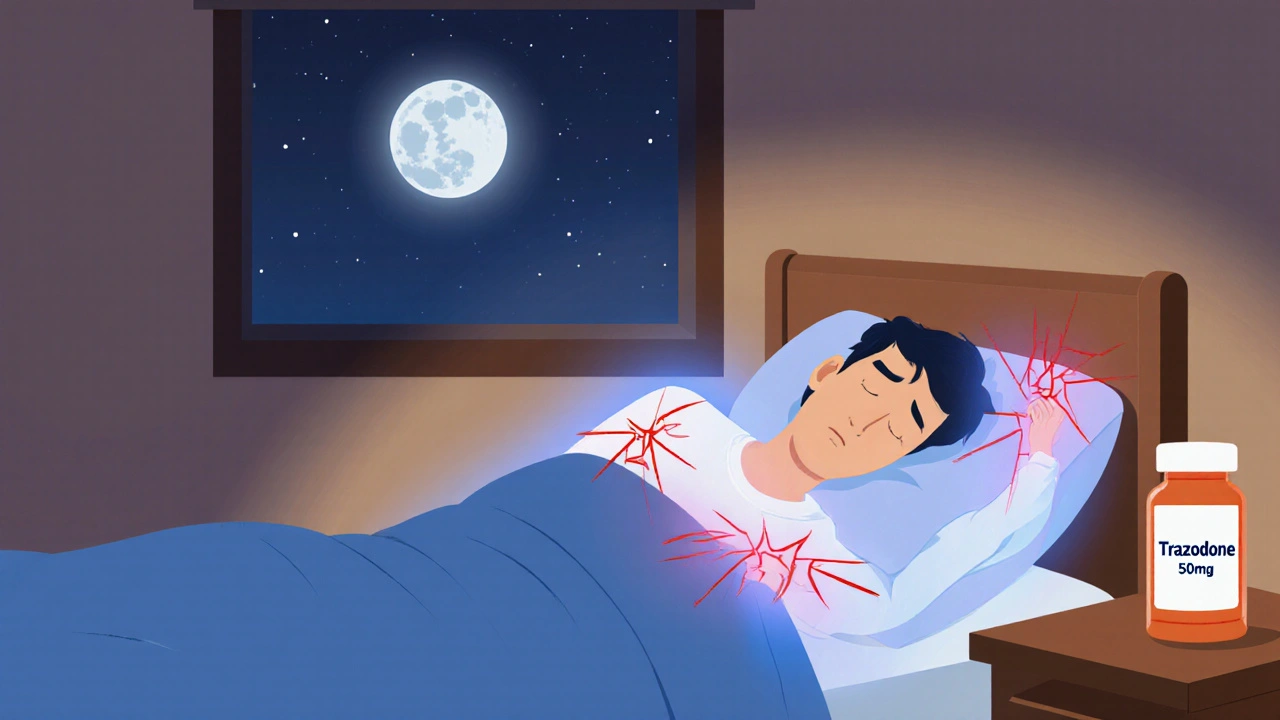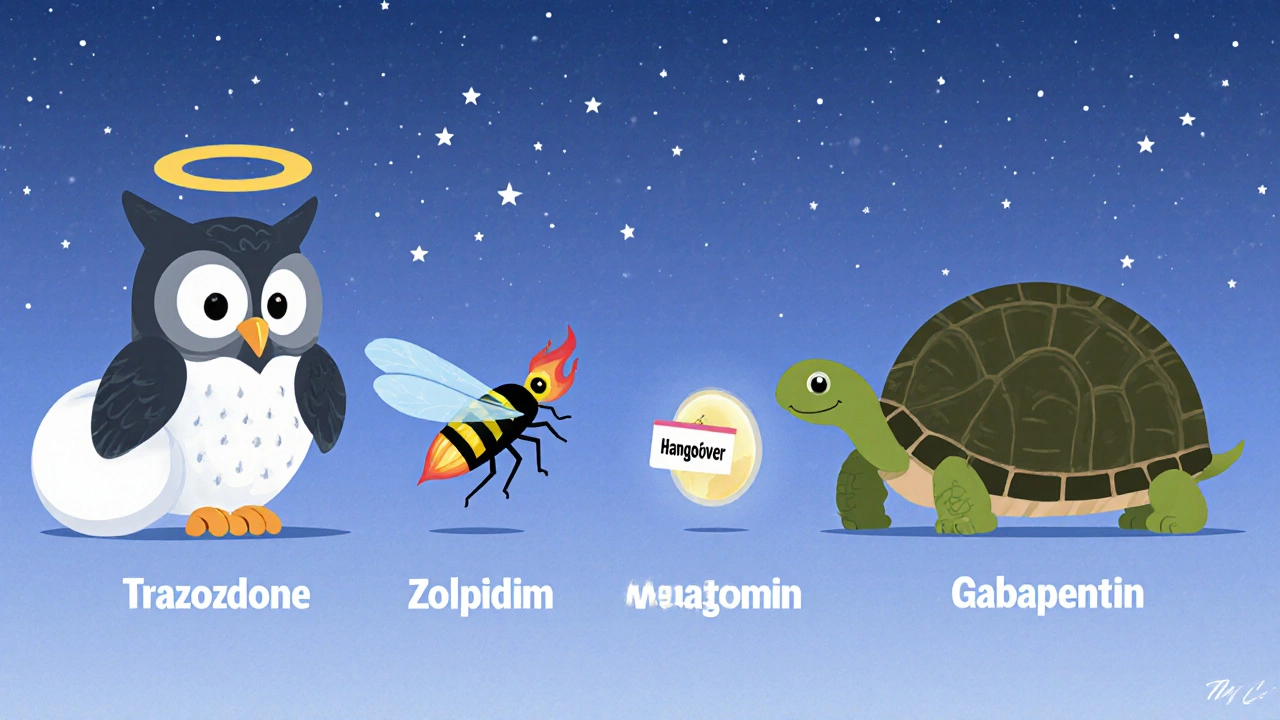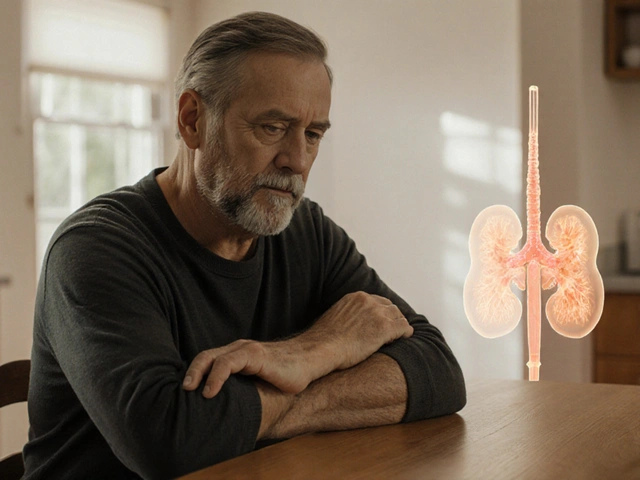
If you have fibromyalgia, you know the cycle: pain keeps you awake, and not sleeping makes the pain worse. It’s a loop that drains you by noon. Many people with fibromyalgia don’t just need painkillers-they need sleep. And that’s where trazodone comes in. It’s not a painkiller like ibuprofen or a muscle relaxer like cyclobenzaprine. But for thousands of people with fibromyalgia, it’s one of the few things that actually helps them get through the night.
Why Sleep Matters More Than You Think
Fibromyalgia isn’t just about achy muscles. The real killer is non-restorative sleep. You might spend eight hours in bed, but your brain never hits deep sleep. That’s when your body repairs itself. Without it, pain signals get louder. Studies from the Journal of Clinical Sleep Medicine show that people with fibromyalgia who get poor sleep report pain levels 40% higher the next day. Trazodone doesn’t fix the root cause of fibromyalgia, but it gives your brain the chance to reset.
What Is Trazodone?
Trazodone is an antidepressant, originally developed in the 1960s. It works by increasing serotonin in the brain-a chemical linked to mood and sleep. At low doses (25-100 mg), it doesn’t act like a typical antidepressant. Instead, it blocks certain receptors that keep you alert, making you drowsy without the grogginess of benzodiazepines. It’s not addictive. It doesn’t cause tolerance the way sleep meds like zolpidem do. That’s why doctors reach for it when other sleep aids fail.
It’s approved by the FDA for depression, but its use for sleep is off-label-meaning it’s legal and common, just not officially labeled for that use. In fact, over 70% of trazodone prescriptions in the U.S. are for insomnia, not depression. In New Zealand, it’s listed on the Pharmaceutical Schedule as a subsidized option for sleep disorders linked to chronic pain.
How Trazodone Helps Fibromyalgia Pain
Here’s the surprising part: trazodone doesn’t directly numb pain. But it reduces the brain’s sensitivity to it. Fibromyalgia is a central sensitization disorder-your nervous system gets stuck on high alert. Trazodone calms that overactivity. A 2023 review in Arthritis Care & Research found that patients taking low-dose trazodone reported a 30% drop in pain intensity over 12 weeks, even without changing other meds.
It also helps with the other symptoms that make fibromyalgia worse: anxiety, brain fog, and fatigue. Better sleep means your body can regulate cortisol and inflammatory markers. One study tracked patients for six months and saw a 25% reduction in morning stiffness and muscle spasms after starting trazodone.
Dosage: Less Is More
Most people start at 25 mg, taken one hour before bed. That’s less than half the dose used for depression. Some need 50 mg. Few need more than 100 mg. Higher doses don’t mean better sleep-they mean more next-day drowsiness, dry mouth, or dizziness.
Take it on an empty stomach or with a light snack. Avoid alcohol. It can turn a gentle sleep aid into a dangerous combo. If you feel dizzy standing up, sit down. Trazodone can lower blood pressure slightly. It’s not dangerous for most, but it’s worth watching, especially if you’re older or on blood pressure meds.
It takes about a week to feel the full sleep effect. Don’t give up after three nights. Some people report feeling more rested after two weeks. Keep a sleep journal: note when you fall asleep, how many times you wake up, and how you feel in the morning.

Side Effects: What to Expect
Most side effects are mild and fade within a week:
- Drowsiness (that’s the goal, but too much? Lower the dose)
- Dry mouth (sip water, chew sugar-free gum)
- Dizziness (stand up slowly)
- Headache (rare, usually goes away)
- Upset stomach (take with food if needed)
Less common but serious: priapism (a painful, prolonged erection-rare, but seek help immediately if it lasts more than 4 hours). Also, if you have a history of heart rhythm problems, talk to your doctor. Trazodone can affect QT intervals, though it’s low risk at sleep doses.
Who Should Avoid It
Trazodone isn’t for everyone. Avoid it if:
- You’ve had a recent heart attack or unstable angina
- You’re taking MAO inhibitors (like phenelzine)-this combo can be deadly
- You’re allergic to trazodone or similar antidepressants
- You have severe liver disease
If you’re pregnant or breastfeeding, talk to your doctor. There’s limited data, but no strong evidence of harm at low doses. Still, most doctors prefer to avoid it unless benefits clearly outweigh risks.
How It Compares to Other Options
Here’s how trazodone stacks up against other common sleep and pain aids for fibromyalgia:
| Medication | Primary Use | Dosage for Sleep | Side Effects | Addiction Risk |
|---|---|---|---|---|
| Trazodone | Sleep, pain sensitivity | 25-100 mg | Drowsiness, dry mouth, dizziness | None |
| Gabapentin | Pain, nerve issues | 300-900 mg at night | Dizziness, weight gain, swelling | Low |
| Pregabalin | Pain, anxiety | 75-150 mg at night | Drowsiness, weight gain, brain fog | Low |
| Zolpidem (Ambien) | Short-term sleep | 5-10 mg | Memory issues, next-day grogginess | High |
| Melatonin | Sleep cycle regulation | 1-10 mg | Mild drowsiness, headache | None |
Trazodone stands out because it’s the only one here that tackles both sleep and pain sensitivity without addiction risk. Gabapentin and pregabalin help pain, but they don’t improve sleep quality the same way. Zolpidem gives you sleep fast-but you wake up feeling hungover. Melatonin helps you fall asleep, but doesn’t keep you asleep through the night.

Real Stories, Real Results
Anna, 54, from Christchurch, started trazodone after three years of poor sleep. She was on gabapentin, but still waking up every two hours. After two weeks on 50 mg of trazodone, she slept six hours straight for the first time in years. "I didn’t realize how much my brain was screaming until it finally quieted down," she says. Her pain score dropped from 8/10 to 5/10.
Mark, 61, in Auckland, tried everything-CBD, magnesium, cognitive behavioral therapy. Nothing stuck. His doctor suggested trazodone. He was skeptical. After a month, he says, "I’m not cured, but I can finally plan my day. I’m not just surviving the night anymore."
What to Do If It Doesn’t Work
If you’ve tried trazodone for six weeks at 50-100 mg and see no improvement, it’s not working for you. That’s okay. Not everyone responds. Talk to your doctor about alternatives:
- Low-dose amitriptyline (another old-school option for fibromyalgia sleep)
- Cognitive behavioral therapy for insomnia (CBT-I)-proven to be as effective as meds
- Combining melatonin with sleep hygiene changes
Don’t increase the dose on your own. Higher doses don’t help sleep-they just increase side effects.
Long-Term Use: Safe?
Yes. Trazodone is one of the safest long-term sleep aids. Unlike benzodiazepines, it doesn’t lose effectiveness over time. A five-year study in Journal of Pain Research followed 212 fibromyalgia patients on low-dose trazodone. No tolerance developed. No withdrawal symptoms when stopped. Most kept using it because it worked.
Regular check-ins with your doctor are still important. Get your blood pressure checked once a year. If you’re over 65, watch for falls-dizziness can increase risk.
Final Thoughts
Trazodone won’t cure fibromyalgia. But for many, it breaks the cycle. Better sleep means less pain. Less pain means more energy. More energy means you can move, stretch, and maybe even enjoy life again. It’s not glamorous. It’s not a miracle. But it’s real. And for people who’ve lost years to sleepless nights, that’s enough.
Can trazodone make fibromyalgia pain worse?
No, trazodone doesn’t make fibromyalgia pain worse. In fact, most people report less pain over time because better sleep reduces central sensitization. Rarely, someone might feel slightly more drowsy or dizzy, which can feel like increased fatigue-but that’s not the same as increased pain. If pain worsens, it’s likely due to another factor, like stress or illness, not trazodone.
How long does it take for trazodone to work for fibromyalgia sleep?
Most people notice improved sleep within 3-7 days. Full benefits-like reduced morning stiffness and lower pain scores-usually take 2-4 weeks. Don’t expect instant results. This isn’t a painkiller. It’s a sleep regulator that helps your body heal over time.
Is trazodone better than melatonin for fibromyalgia?
It depends. Melatonin helps you fall asleep faster, but doesn’t keep you asleep. Trazodone helps you stay asleep longer and reduces pain sensitivity. If you wake up every hour, melatonin won’t fix that. If you can’t fall asleep at all, melatonin might help first. Many people use both: melatonin to fall asleep, trazodone to stay asleep.
Can I take trazodone with other fibromyalgia meds?
Yes, but not without checking. Trazodone is safe with gabapentin, pregabalin, and low-dose antidepressants like duloxetine. But avoid it with MAO inhibitors, certain antibiotics (like linezolid), or high-dose SSRIs. Always tell your doctor everything you’re taking-even supplements like St. John’s Wort.
Will I gain weight on trazodone?
Weight gain is possible, but less common at low doses. At 50 mg or less, most people see no change. Higher doses (above 150 mg) are more likely to cause increased appetite. If you notice weight gain, focus on portion control and light movement. It’s not a reason to stop the med-just something to watch.
If you’re considering trazodone, talk to your doctor. Bring your sleep diary. Ask about alternatives. This isn’t a one-size-fits-all fix. But for many with fibromyalgia, it’s the quiet, steady help they’ve been waiting for.




